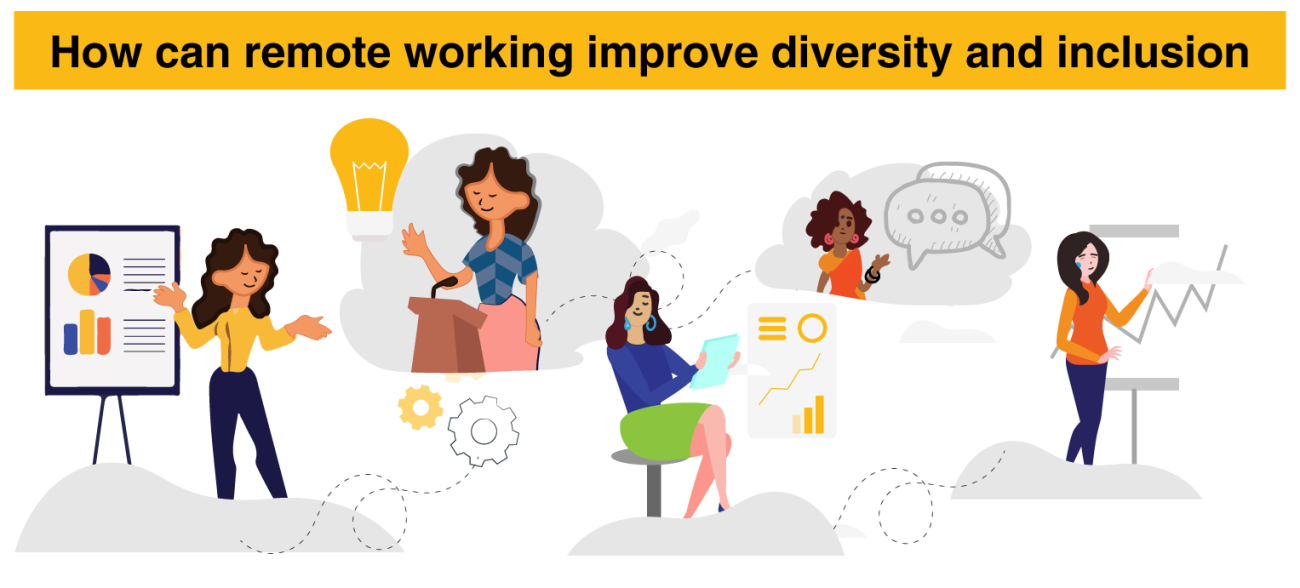How can remote working improve diversity and inclusion
Remote working is gaining a positive momentum for many reasons including increased productivity, lowered attrition rates, and happier employees. But something that is less talked about is how remote working actually levels the playing field for all employees by improving diversity and inclusion.
Though organizations might encourage neutral standpoints and inclusivity, human beings harbor conscious or unconscious biases that can sometimes cloud the judgement of individuals within an organization. These could be based on issues of race, gender, and sexual orientation and make us react or behave differently with our counterparts.
Remote work environment has a two-fold benefit:
It helps in fading these biases into the background and shifts the focus largely on productivity and effectiveness and not on the physicality of people - which is the usual source of biases to begin with. Remote working also helps people come together to understand each other’s value through the work rather than any other criteria.
It enables different diverse groups, like the LGBTQ communities, differently-abled, unconventional family units (like single mothers), etc to enter the workforce more easily by reducing the need to be physically present in offices and providing flexibility. Remote work environments aid working women to stay put in their job roles, irrespective of events in their life cycles, especially maternity. The drop out rate of women who tend to move out of the workforce, to manage their families and children is at a whopping 42%.
So, how does remote working help?
Remote working can help in restructuring the workplace to include a number of groups who have been marginalized. For example, new parents, and especially single ones, often struggle with returning to work after a baby is born or adopted.
According to a recent study by Zapier, about three-quarters of knowledge workers would be willing to quit a job that didn’t allow remote working for one that did. According to the participants, remote working is more productive, helps them save money and time. They get to spend more time with their family and pets. They can care for their children and the elderly without compromises.
How does remote working help the underrepresented communities?
- Mitigates biases: Reduces the potential for discrimination as the remote employees are largely judged by the work they do rather than any other criteria - including age, gender, physical appearance, background, et al. Remote working can possibly help improve equalization of opportunities and personalities, and can increase the chances of everyone being seen and heard.
- Provides opportunities for the differently-abled: Remote working can provide ample opportunities for the differently-abled who might otherwise have trouble with commuting, workplace accessibility, and possibly a perception of their lower performance owing to their disability. Remote working helps overcome some of the social stigmas and provides them the opportunities to work in an environment that is tailored to their specific needs.
- Levels the playing field for women: Ends the ‘follow-the-spouse’ syndrome for married women. By being able to work remotely and not being constrained by geographies, women are at an advantage to continue to grow in their roles and climb up the corporate ladders without having to give up their jobs to follow their spouse, in case of relocations or life changes that demand moving cities.
Furthermore, maternity usually impedes women’s ability to sustain their growth on the career path owing to the unavailability of a support system. 42% of whom cut back on work hours to care for family. Remote work mitigates the need for women to be physically away from their young children (especially for long hours) and encourages them to take on larger roles and come back to work sooner with a choice of flexible working hours and compensations.
- Provides a level playing field for communication: Remote work reduces dependence on physical signals, and shifts the focus more on the work itself. Though remote working reduces chances of team bonding, on the plus side, it tends to improve the equalization of opportunity for everyone to be heard by shifting away from the source of a lot of biases. It might not be that the loudest person is the only one heard anymore!
For example, women have a better chance to make themselves heard. Studies as recently as 2014 have shown that women are more likely to be interrupted than men. Incorporating faceless (online) communication channels (such as emails, text messages, etc) can further improve the chances of everyone having an equal opportunity to express their ideas and mitigate the biases a little more.
- Encourages work-life integration: Remote working gives everyone an opportunity to design and navigate their days based on their priorities of home and family. It frees employees from the time lost in travel as well. Family units can better integrate work-life balance as remote working also helps men contribute more to domestic activities and spend more time with their family and care for their children and elderly without compromises, thus encouraging gender equality further.
Maybe the pandemic pushed most of us to confine ourselves within the walls of our homes to work and pushed us to run a relay race with our spouses or partners to stay afloat to keep our jobs. But it has also made us reconsider and change our perspectives about remote working, in terms of the advantages it provides for different diverse groups. There are clear benefits to continue these working models well beyond the pandemic.
If you are thinking about signing up for a remote working model for the long haul, you can read here about how you can make remote teams work more efficiently.
FlexiBees has provided companies, both startups, and established players, with part-time talent for many projects and roles; across a variety of functions & skill-sets like Inside Sales, Business Development, Marketing, Digital Marketing, Public Relations, Investment Banking, Technology, Content Development, Writing, Graphic Design, etc. All these companies have benefited by being able to hire high-quality talent at pricing optimised only for the hours of work they need. With the COVID-19 pandemic leading to businesses trying new approaches, strategies, MVPs, etc, part-time and project-based talent, that is high-quality and affordable, can help.
If you have a role requirement, take 2 minutes to fill our form and we will try our best to fulfill it for you, quickly and to your satisfaction.
If you have a role requirement, take 2 minutes to fill our form and we will try our best to fulfill it for you, quickly and to your satisfaction.


